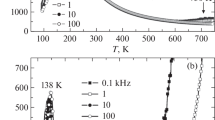Abstract
This paper reports on the results of the investigation into the dielectric properties of perovskite ceramics of the relaxor ferroelectrics (1 − x)(NaBi)1/2TiO3−x Bi(ZnTi)1/2O3 (x < 0.2) with the use of the impedance spectra measured in the frequency range from 25 to 106 Hz at temperatures from 100 to 1000 K. It has been found that the temperature dependence of the real part of the permittivity is characterized by a maximum at a temperature T′ m (590–610 K). It has been shown that, in the temperature region of the existence of the relaxor state (T < T′ m ), the permittivity ɛ is determined by the sum of the contributions from the matrix and dipole clusters. The temperature dependence of the contribution from the clusters, which is determined by the kinetics of their formation and freezing, is characterized by a curve with a maximum. It has been revealed that, in the temperature range T > T′ m , there are two mechanisms of polarization. One mechanism is associated with the thermal hopping motion of charges, whereas the other mechanism provides an induction-type response (system with a negative capacitance). The latter makes a negative contribution to the real part of the permittivity ɛ and a positive contribution to the imaginary part of the permittivity. A quantitative analysis of the experimental data has been carried out with the use of an equivalent circuit that includes a constant-phase element of the induction type.
Similar content being viewed by others
References
G. A. Smolenskii, V. A. Isupov, A. I. Agranovskaya, and N. N. Krainik, Sov. Phys. Solid State (Leningrad) 2(12), 2651 (1960).
G. O. Jones and P. A. Thomas, Acta Crystallogr., Sect. B: Struct. Sci. 58, 168 (2002).
V. A. Isupov, Ferroelectrics 315, 123 (2005).
G. A. Samara, J. Phys.: Condens. Matter 15, R367 (2003).
J. Suchanicz, J. Kusz, H. Bohm, H. Duda, J. P. Mercurio, and K. Konieczny, J. Eur. Ceram. Soc. 23, 1559 (2003).
P. Marchet, E. Boucher, V. Dorcet, and J. P. Mercurio, J. Eur. Ceram. Soc. 26, 3037 (2006).
A. N. Salak, N. P. Vyshatko, A. L. Kholkin, V. M. Ferreira, N. M. Olekhnovich, Yu. V. Radyush, and A. V. Pushkarev, Mater. Sci. Forum 514–516, 250 (2006).
Yu. V. Radyush and N. M. Olekhnovich, in Proceedings of the International Scientific Conference “Actual Problems of Solid State Physics,” Minsk, Belarus, October 18–21, 2011 (Minsk, 2011), Vol. 1, p. 85.
M. R. Suchomel, A. W. Fogg, M. Allix, H. Niu, J. B. Claridge, and M. J. Rosseinsky, Chem. Mater. 18, 4987 (2006).
E. Barsoukov and J. R. Macdonald, Impedance Spectroscopy: Theory, Experiment, and Applications (Willey, New York, 2005).
D. Viehland, S. J. Jang, L. E. Cross, and M. Wuttig, J. Appl. Phys. 68, 2916 (1990).
N. A. Poklonski, S. V. Shpakovskii, N. I. Gorbachuk, and S. B. Lastovskii, Semiconductors 40(7), 803 (2006).
Author information
Authors and Affiliations
Corresponding author
Additional information
Original Russian Text © N.M. Olekhnovich, Yu.V. Radyush, A.V. Pushkarev, 2012, published in Fizika Tverdogo Tela, 2012, Vol. 54, No. 11, pp. 2100–2105.
Rights and permissions
About this article
Cite this article
Olekhnovich, N.M., Radyush, Y.V. & Pushkarev, A.V. Mechanisms of dielectric polarization in perovskite ceramics of the relaxor ferroelectrics (1 − x)(NaBi)1/2TiO3−x Bi(ZnTi)1/2O3 (x < 0.2). Phys. Solid State 54, 2236–2242 (2012). https://doi.org/10.1134/S1063783412110248
Received:
Published:
Issue Date:
DOI: https://doi.org/10.1134/S1063783412110248




